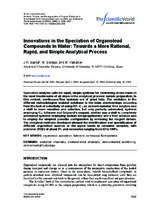Mostrar el registro sencillo del ítem
Innovations in the Speciation of Organolead Compounds in Water: Towards a More Rational, Rapid, and Simple Analytical Process
| dc.contributor.author | Baena, J.R. | |
| dc.contributor.author | Gallego, M. | |
| dc.contributor.author | Valcárcel, M. | |
| dc.date.accessioned | 2015-10-05T10:13:20Z | |
| dc.date.available | 2015-10-05T10:13:20Z | |
| dc.date.issued | 2002 | |
| dc.identifier.uri | http://hdl.handle.net/10396/12944 | |
| dc.description.abstract | Speciation analysis calls for rapid, simple systems for minimizing errors made in the most troublesome of all steps in the analytical process: sample preparation. In this context, continuous-flow systems are of great help. The evolution in the different methodologies enabled solutions to the main shortcomings occurring from the lack of selectivity of using RP–C18 as sorbent material. One solution was a shift to more sensitive and selective, but only partially automated, systems employing C60 fullerene and Grignard´s reagent; another was a shift to completely automated systems employing sodium tetrapropylborate; and a final solution was to employ the simplest possible configuration by removing the reagent stream. The analytical methods developed allowed the identification and quantification of different organolead species at the pg/ml levels in rainwater samples, with precision (RSD) of about 5% and recoveries ranging from 92 to 100%. | es_ES |
| dc.format.mimetype | application/pdf | es_ES |
| dc.language.iso | eng | es_ES |
| dc.publisher | The Scientific World | es_ES |
| dc.rights | https://creativecommons.org/licenses/by-nc-nd/4.0/ | es_ES |
| dc.source | TheScientificWorld Journal 2, 1332-1337 (2002) | es_ES |
| dc.subject | Organolead | es_ES |
| dc.subject | Fullerene | es_ES |
| dc.subject | Continous flow systems | es_ES |
| dc.title | Innovations in the Speciation of Organolead Compounds in Water: Towards a More Rational, Rapid, and Simple Analytical Process | es_ES |
| dc.type | info:eu-repo/semantics/article | es_ES |
| dc.relation.publisherversion | http://www.hindawi.com/journals/tswj/ | |
| dc.rights.accessRights | info:eu-repo/semantics/openAccess | es_ES |

